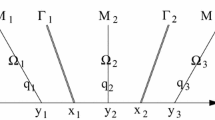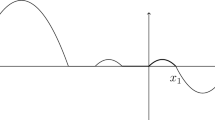Abstract
We prove that if a reaction-diffusion equation (in one space dimension) has asymptotically stable, exponentially localized traveling wave solutions then there are solutions of the system which are nearly the linear superposition of two such pulses moving in opposite directions away from one another. Moreover, such solutions are themselves asymptotically stable. This result is meant to complement analytic or numeric studies into interactions of such pulses over finite times which might result in the scenario treated here. Since the pulses are moving in opposite directions, it is not possible to put the problem into a moving reference frame which renders the linear problem autonomous. We overcome this difficulty by embedding the original system in a larger one wherein the linear part can be written as a time independent piece plus another piece which, even though it is non-autonomous and large, has certain properties which allow us to treat it as if it were a small perturbation.
Similar content being viewed by others
References
Alexander J.C., Jones C.K.R.T.: Existence and stability of asymptotically oscillatory double pulses. J. Reine Angew. Math. 446, 49–79 (1994)
Amann, H.: Linear and Quasilinear Parabolic Problems, vol. I, vol. 89 of Monographs in Mathematics. Birkhäuser Boston Inc., Boston, MA (1995). Abstract linear theory
Beyn, W.-J., Selle, S., Thümmler, V.: Freezing multipulses and multifronts. Preprint (2007)
Evans J.W., Fenichel N., Feroe J.A.: Double impulse solutions in nerve axon equations. SIAM J. Appl. Math. 42(2), 219–234 (1982)
Feroe J.A.: Existence and stability of multiple impulse solutions of a nerve equation. SIAM J. Appl. Math. 42(2), 235–246 (1982)
Hastings S.P.: Single and multiple pulse waves for the FitzHugh-Nagumo equations. SIAM J. Appl. Math. 42(2), 247–260 (1982)
Henry D.: Geometric Theory of Semilinear Parabolic Equations, vol. 840 of Lecture Notes in Mathematics. Springer-Verlag, Berlin (1981)
Nishiura, Y., Teramoto, T., Ueda, K.-I.: Scattering of traveling spots in dissipative systems. Chaos 15(4), 047509, 10 (2005)
Sandstede B.: Stability of multiple-pulse solutions. Trans. Am. Math. Soc. 350(2), 429–472 (1998)
Scheel, A., Wright, J.D.: Colliding dissipative pulses—the shooting manifold. Preprint (2007)
Zelik, S., Mielke, A.: Multi-pulse evolution and space-time chaos in dissipative systems. Preprint (2006)
Author information
Authors and Affiliations
Corresponding author
Rights and permissions
About this article
Cite this article
Wright, J.D. Separating Dissipative Pulses: The Exit Manifold. J Dyn Diff Equat 21, 315–328 (2009). https://doi.org/10.1007/s10884-009-9130-0
Received:
Published:
Issue Date:
DOI: https://doi.org/10.1007/s10884-009-9130-0




